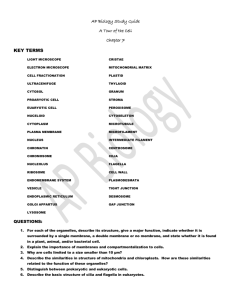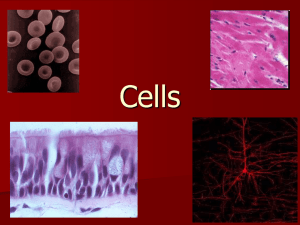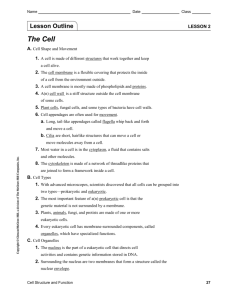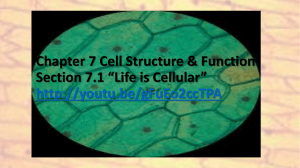The Cell
advertisement
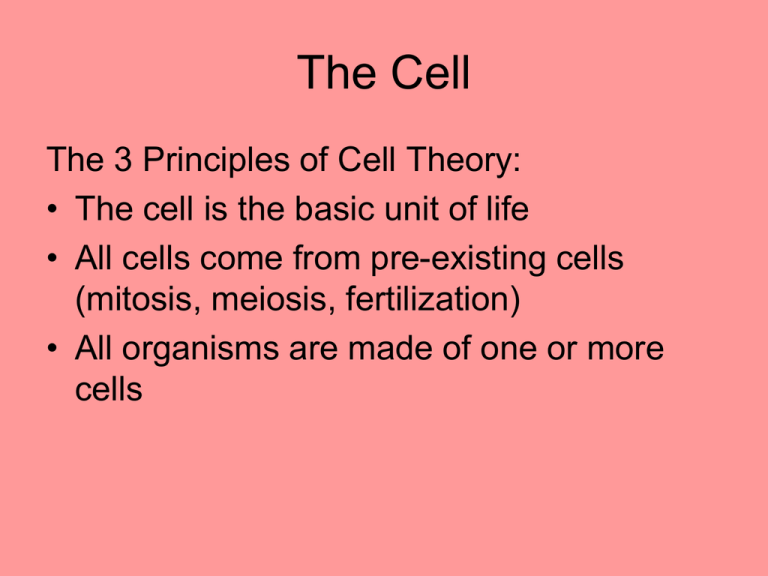
The Cell The 3 Principles of Cell Theory: • The cell is the basic unit of life • All cells come from pre-existing cells (mitosis, meiosis, fertilization) • All organisms are made of one or more cells The scale Of Things! Why are cells so small? Prokaryotic vs. Eukaryotic Cells Prokaryotic Primitive Simple DNA is in nucleiod region No membrane bound organelles Smaller (1-3 µm Ave.) Bacteria, Archae Eukaryotic modern complex DNA is in nucleus membrane bound organelles Larger (10-30 µm) Protists, Fungi, Plants Animals Prokaryotic Cell Eukaryotic Cell Plant Cell vs. Animal Cell •Cell Wall •Chloroplasts •Central Vacuole Plant Cell Plant Cell vs. Animal Cell •Centrioles •Cilia and Flagella •More Lysosomes Animal Cell Organelles: The Nucleus Controls cell activities Contains the DNA (DNA = hereditary material) Parts: Nuclear envelope Pores Nucleolus (RNA) Organelles: Ribosomes Ribosomes = site of protein synthesis (can be free floating or attached to ER) Organelles: ER (Endoplasmic Reticulum) Rough ER = has ribosomes Smooth ER = no ribosomes So difference in function? Rough has protein synthesis occur on it and smooth does not Form channels of membrane for transport of materials in cell Organelles: Golgi Apparatus Sorts and packages materials Endomembrane System Organelles: Lysosomes Contain hydrolytic (digestive) enzymes Breakdown worn out parts of the cell Organelles: Mitochondria (powerhouse) Function: Cellular Respiration releases energy for the cell to use Parts: Outer membrane Inner Membrane Cristae Matrix Organelles: Chloroplast (plastid) Function: produce and store food Parts: Outer Membrane Inner Membrane Grana Stroma Chloroplast and Mitochondria • • • • • Semi-autonomous organelles Both have double membranes Both have their own DNA Both make some of their own proteins Cells on their own at one time?? Organelles: Vacuoles Animals: small vacuoles Plants: central vacuole •Stores toxins •Water regulation •Lysosomal function Outside membrane= tonoplast Microbodies: convert harmful substances into useful ones i.e. peroxisome 2H2O2 2H2O + 2O2 Peroxisome converts hydrogen peroxide to water and oxygen Cytoskeleton: movement of organelles, shape and support Microtubules, microfilaments, intermediate filaments Organelles: Cilia and Flagella Structure of cilia and flagella (9 + 2 arrangement) Cell to Cell Junctions: Plants-Plasmodesmata Cell to Cell Junctions: Animal Cells Desmosomes Gap junctions Tight Junctions Cell Membrane: Fluid-Mosaic Model Cell Membrane: made of phospholipids and proteins


